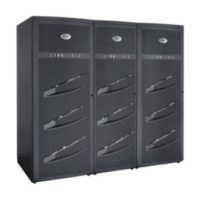104
EMC Symmetrix DMX-3 Product Guide
Symmetrix DMX-3 Input/Output Operations
◆ Using the prefetch algorithm, the disk director dynamically
detects sequential data access patterns to the disk drives. The
directors improve the hit ratio of these accesses by promoting
blocks from the disk drives to global memory slots before that
data has been requested. The prefetch algorithm is designed to
minimize seek and latency on the disks, and to provide good
response times.
◆ The disk director manages access to the disk drives. When a read
miss occurs, the disk director also stages tracks into global
memory. It also performs a background operation that destages
written-to blocks to disk.
Prefetch algorithm Symmetrix systems continually monitor I/O activity and look for
access patterns. When the second sequential I/O to a track occurs, the
sequential prefetch process is invoked and the next track of data is
read into global memory. The intent of this process is to avoid a read
miss. When the host processor returns to a random I/O pattern, the
Symmetrix system discontinues the sequential process.
The intelligent, adaptive prefetch algorithm reduces response time
and improves the utilization of the disks. The prefetch algorithm
maintains, per each logical volume, an array of statistics and
parameters based on the latest sequential patterns observed on the
logical volume. Prefetch dynamically adjusts, based on workload
demand across all resources in the back end of the Symmetrix system.
This algorithm also ensures that global memory resources are never
overly consumed in order to maintain optimal performance.
Enginuity uses an intelligent algorithm attuned to “real-life”
workloads and dynamic usage patterns which will detect sequences
quickly, but prefetch only when the probability of increasing global
memory hits is high. It will place data in memory on time and
without interfering with other system activities. The prefetch to
memory resulting in global memory hits dramatically improves
response to a host request by as much as a factor of 10. It also
optimizes back-end utilization by transferring large portions of data
in each instance, minimizing seek and latency delays associated with
I/O operations directly from disk.
By incorporating intelligent prefetch algorithms, Enginuity
prefetches all the data that is needed—and only the needed
data—and does it on time, without affecting the response time of
other I/O events. Enginuity’s algorithms are the most sophisticated
and advanced in the industry and are optimized for what you need
next. They can adjust for real-world situations and intelligently
choose the method that works best for a given situation.

